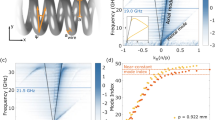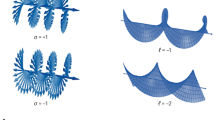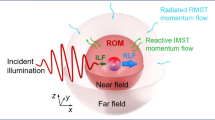Abstract
Circular birefringence of purely geometric origin was recently predicted1 and observed2 in helically coiled monomode optical fibres, and widely reported3–5 as a successful application to photons of a general theory6,7 for phase shifts in adiabatically transported quantum states. However, earlier similar observations8–10 had been interpreted not by quantum mechanics but simply as a classical anholonomy, namely parallel transport of the polarization11. Indeed, because the magnitude of the effect is independent of the wavelength of the light as well as Planck's constant, it might seem that 'classical' here means that not only quantum but also wave effects can be neglected. Here, I argue that these experiments, and their discrete analogues, are most appropriately described at the level of classical electromagnetism; the parallel transport law can then be derived (rather than assumed8–11) and nonadiabatic polarization changes calculated.
This is a preview of subscription content, access via your institution
Access options
Subscribe to this journal
Receive 51 print issues and online access
$199.00 per year
only $3.90 per issue
Buy this article
- Purchase on Springer Link
- Instant access to full article PDF
Prices may be subject to local taxes which are calculated during checkout
Similar content being viewed by others
References
Chiao, R. Y. & Wu, Y. S. Phys. Rev. Lett. 57, 933–936 (1986).
Tomita, A. & Chiao, R. Y. Phys. Rev. Lett. 57, 937–940 (1986).
Maddox, J. Nature 323, 199 (1986).
Robinson, A. L. Science 234, 424–426 (1986).
MacCallum, M. New Scient. 1536, 22 (1986).
Berry, M. V. Proc. R. Soc. A392, 45–57 (1984).
Simon, B. Phys. Rev. Lett. 51, 2167–2170 (1983).
Ross, J. N. Optical Quantum Electron. 16, 455–461 (1984).
Varnham, M. P., Birch, R. D. & Payne, D. N. Tech. Dig. Int. Conf. Integrated Optics Optical Fiber Commns. Eur. Conf. Opt. Comms. 135–138 (Instituto internazionale delle Communicazione, Genova, 1985).
Varnham, M. P., Birch, R. D., Payne, D. N. & Love, J. D. Tech. Dig. Conf. Opt. Fiber Comms. Atlanta 68–71 (Optical Society of America, 1986).
Haldane, F. D. M. Optics Lett. 11, 730–732 (1986).
Bialynicki-Birula, I. & Bialynicki-Birula, Z. Phys. Rev. D (in the press).
Born, M. & Wolf, E. Principles of Optics (Pergamon, London, 1959).
Kline, M. & Kay, I. M. Electromagnetic Theory and Geometrical Optics (Interscience, New York, 1965).
Snyder, A. W. & Love, J. D. Optical Waveguide Theory (Chapman and Hall, London, 1983).
Weatherburn, C. E. Elementary Vector Analysis (Bell, London, 1955).
Kitano, M., Yabuzuaki, T. & Ogawa, T. Phys. Rev. Lett. 58, 523 (1987).
Chow, W. W., Gea-Banacloche, J., Pedrotti, L. M., Sanders, V. E., Schleich, W. & Scully, M. O. Rev. mod. Phys. 57, 61–104 (1985).
Author information
Authors and Affiliations
Rights and permissions
About this article
Cite this article
Berry, M. Interpreting the anholonomy of coiled light. Nature 326, 277–278 (1987). https://doi.org/10.1038/326277a0
Received:
Accepted:
Issue Date:
DOI: https://doi.org/10.1038/326277a0
This article is cited by
-
Experimental observation of Berry phases in optical Möbius-strip microcavities
Nature Photonics (2023)
-
Covariant formulation of spin optics for electromagnetic waves
Applied Physics B (2023)
-
Spin–orbit coupling of light in asymmetric microcavities
Nature Communications (2016)
-
Spatial pattern characterization of linear polarization-sensitive backscattering Mueller matrix elements of human serum albumin sphere suspension
Journal of Biological Physics (2013)
-
Geometrodynamics of spinning light
Nature Photonics (2008)
Comments
By submitting a comment you agree to abide by our Terms and Community Guidelines. If you find something abusive or that does not comply with our terms or guidelines please flag it as inappropriate.



